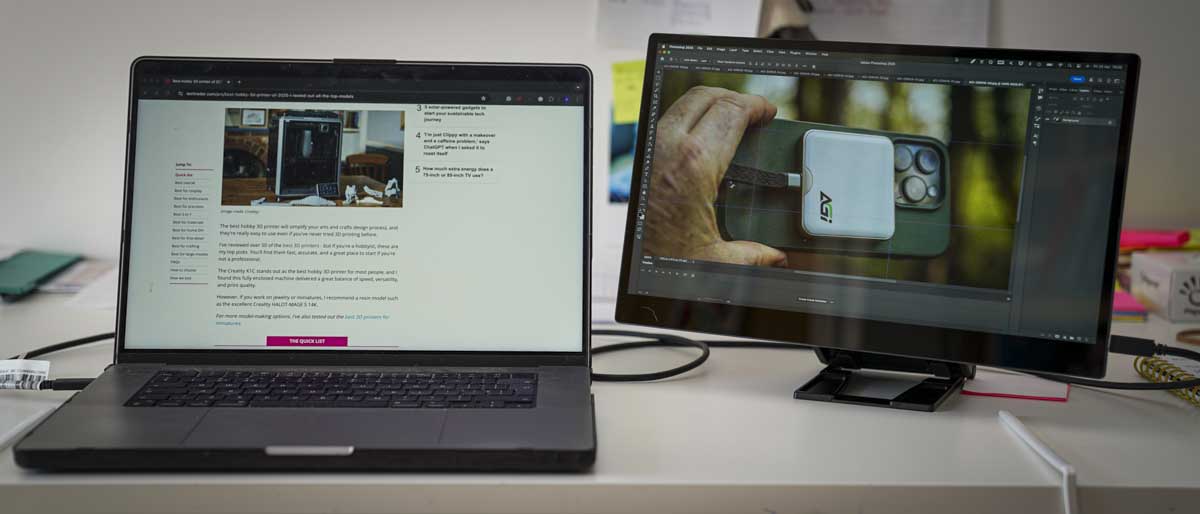TechRadar Verdict
The espresso 15 Pro is an ideal partner for any creative or business user. The laptop screen is bright, and through both real-world and benchmarking tests, the screen proved to be of exceptionally high quality. Though slightly over-reflective and with audio quality that lacks, this is still one of the best portable monitors for creatives.
Pros
- +
4K resolution
- +
High % Adobe RGB
- +
Exceptional build quality
Cons
- -
Low-quality speakers
- -
Limited screen adjustment
- -
Weighty for a 15-inch screen
Why you can trust TechRadar
espresso 15 Pro: 30-second review
The first thing that struck me about the espresso Pro 15 was its incredibly high build quality. The main casing is fashioned from full anodised aluminium with a hardened glass screen that, although a little overly reflective, creates a robust and solid feel. Included with the monitor is an ingenious solid metal stand; this folds out, enabling you to adjust the tilt and height of the monitor so you can place the screen to the side of your laptop or above.
The overall design has been kept minimalistic, and there are no buttons on the side—just the two USB Type-C ports that you use to plug directly into your laptop or an external power source, depending on where you're getting your display feed from, and it works with both Mac and PC systems. Design-wise, it's not dissimilar to the non-Pro espresso 15 and the espresso 17 Pro in its minimalism.
This fully touchscreen-enabled monitor is essentially plug-and-play, and there are two nifty apps that you can download to support it. One is a fully featured whiteboard and drawing application, and the other is the espresso flow software that adds greater control and management to the screen and its use.
Getting started is fast and straightforward: simply plug the single USB Type-C cable between the monitor and your laptop, and it will click into life. All adjustments for brightness, contrast, and audio are made with a touchscreen gesture that reveals the three settings options. These adjustments are nicely designed and fully touch-enabled but with no numerics on the on-screen display, just bars. These adjustments lack accuracy, which is a bit of a shame.
Through testing, one of the features I really liked was the USB Type-C display connector. This enabled any device that supports USB Type-C display to automatically work with this monitor. It's worth noting, though, that you will need to plug in a separate power supply if you are connecting to an iPad, iPhone, or camera. If your machine only runs HDMI, then a simple USB Type-C to HDMI adapter will also enable you to connect. Likewise, if you're using a dock, you'll need to ensure the USB Type-C output has enough power to support the monitor.
Further monitor quality tests showed that it did exceptionally well with high results across the board, especially with the gamut, where it scored 45 out of 50 and reached 89% Adobe RGB, which is essential for any creative monitor and exceptionally good for a portable option.
The screen uniformity was generally quite good, though there were some hotspots towards the bottom right of the monitor and the top. However, you wouldn't be able to see this visually, and it was only picked up in the benchmarking tests with the Datacolor Spyder X2.
Sign up to the TechRadar Pro newsletter to get all the top news, opinion, features and guidance your business needs to succeed!
Considering that this monitor features the full Adobe RGB colour space, 4K resolution, and exceptionally high build quality, it makes an ideal choice for any creative or business professional looking for the best portable monitor to use in the field.
espresso 15 Pro: Price and availability
- How much does it cost? £699 / $699
- When is it out? Now
- Where can you get it? Direct from espresso or from B&H Photo
The espresso 15 Pro is available directly from the Espresso website or through more specialised online retailers, including B&H Photo.
- Value: 4 / 5
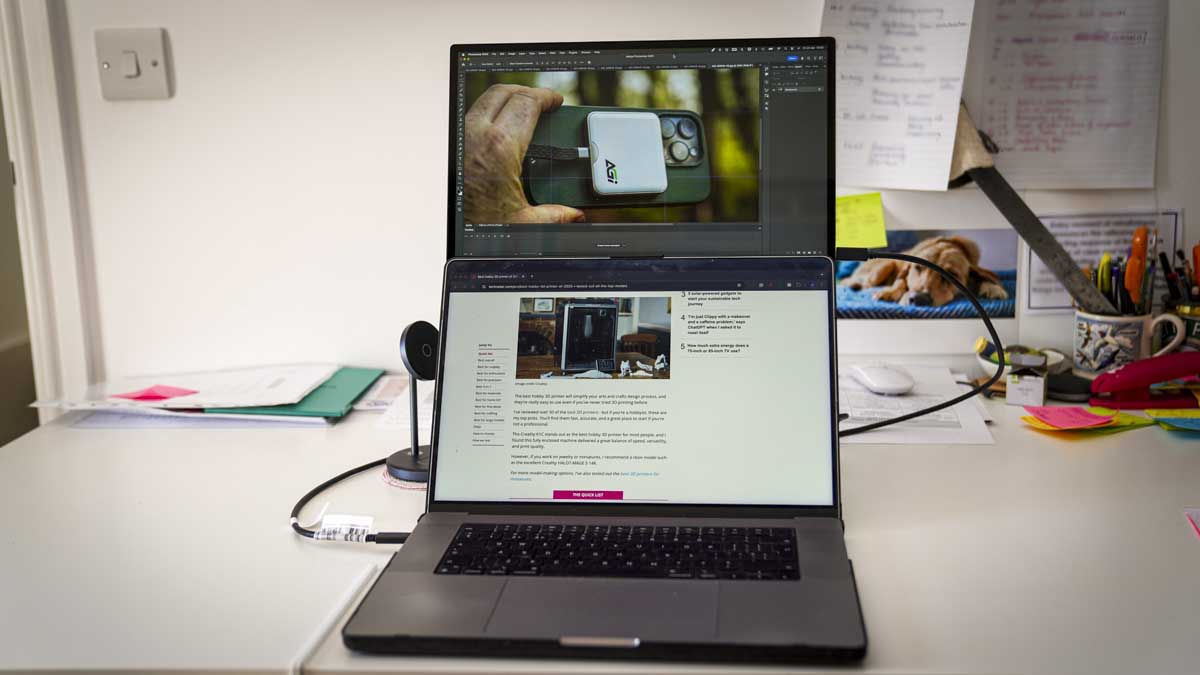
espresso 15 Pro: Specs
Size: 360 x 225 x 9.0 mm
Weight: 800 g
Brightness: 550 nits
Ports: 2x USB-C
Colour space: 100% Adobe RGB
Max refresh rate: 60Hz
Number of colours: 1.07 billion
Resolution: 3840 x 2160p (4K)
Orientations: Support portrait and landscape
Material: Anodised aluminium, 6H hardness glass
espresso 15 Pro: Design
My first impression on lifting the monitor out of the box, especially after having looked at several portable monitors in the last month, was that it was instantly apparent that the espresso Pro 15-inch was something a little bit different. First and foremost, the build quality, with the metal casing, gives it a high-quality feel. As you check over the rest of the monitor, it's just exceptionally slick, with no buttons—just those two USB Type-C ports on the side—and an otherwise completely smooth finish on the back, as well as a really high-quality LCD screen.
When it comes to size and weight, it weighs in at 800g, which is slightly more than some portable monitors, but the build quality is that much higher. The dimensions also mean that the screen dominates most of the front of the unit, although there is still a bezel, and the total dimensions—360 x 225 x 9 mm—make it extremely slim-lined.
Included with the monitor is a magnetic stand, so you can essentially use this as a monitor or as a drawing tablet if you also purchase the pen accessory (although I didn't have this to test in this particular review).
One of the benefits of such a simplistic design is that when you slip it into your backpack or laptop bag, it slides in smoothly with no worries about anything catching. The monitor stand, although slightly weighty, is incredibly robust and offers plenty of flexibility in positioning. Once the monitor is magnetically connected to the stand, it stays perfectly still and is incredibly stable.
Connecting the monitor is very straightforward. If you're connecting it to your laptop, the single USB Type-C cable connects directly to the laptop or another device. If, for some reason, your USB Type-C display port doesn't enable power delivery, the second USB Type-C port can be used for power. For example, if you're connecting it to a camera, like the Sony A7 Mark IV, you can connect via HDMI to USB Type-C into the monitor, then a power station into the second USB Type-C port to supply the power, making it a lightweight solution.
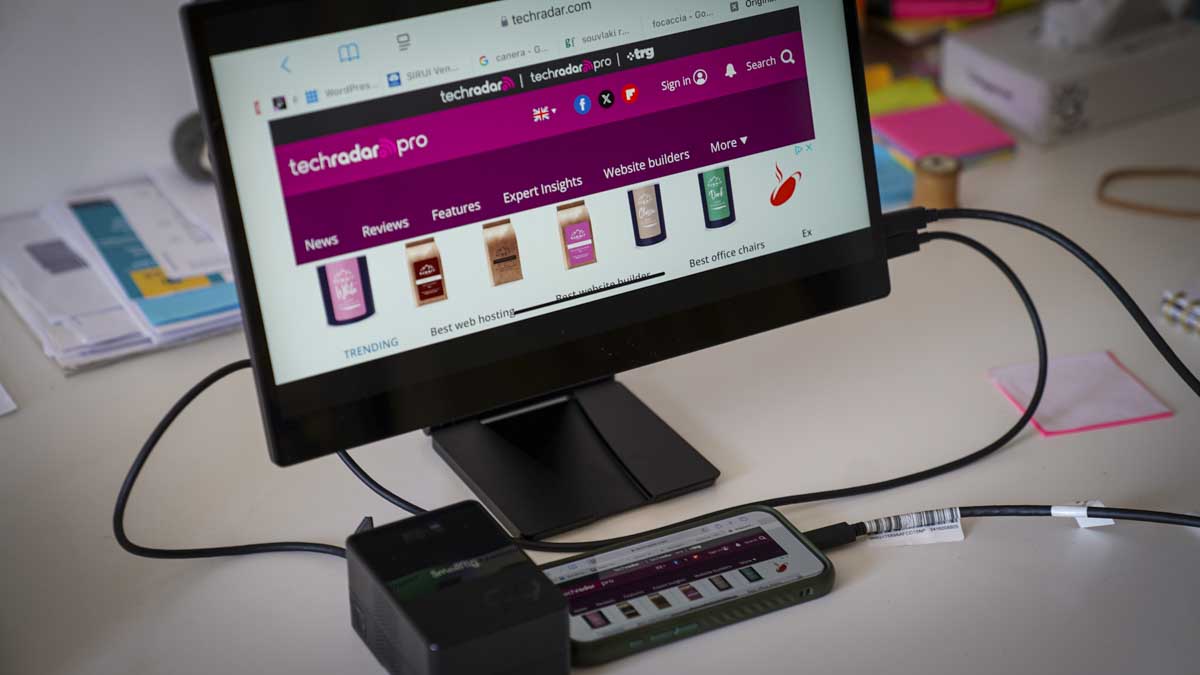
Out of the box, you can't fail to notice that there are exterior buttons to adjust settings. However, once it's plugged in and powered on, a simple swipe up reveals the brightness, contrast, and volume settings, all of which are touch enabled. While these can be adjusted with a swipe up or down, it's worth noting that there are no numerics—just bars—so actual precision for adjustments isn't available through the touchscreen interface.
I found that the monitor was recognised by my MacBook Pro and One Max, and the touchscreen functionality was instantly recognised as a magic pad without the need to install any software. Espresso recommends installing the espressoFlow software, and once this is done, it offers a few more workflow options, including the ability to snap windows to the top, bottom, sides, or wherever you want them laid out. It also recognises auto-rotation, which it doesn't do out of the box, and integrates better with your macOS or Windows system.
It's also worth mentioning that alongside the monitor, there is a range of accessories (although none of these were shipped with my review sample). These include the charge power station, which allows you to use the monitor with devices that have a display out but lack enough power to also supply the monitor. There are also screen protectors (which are always worth buying for touchscreen devices), a case to keep it protected during transport, further stands, and the stylus (which I would highly recommend, having used a third-party option for this review).
- Design: 4.5 / 5
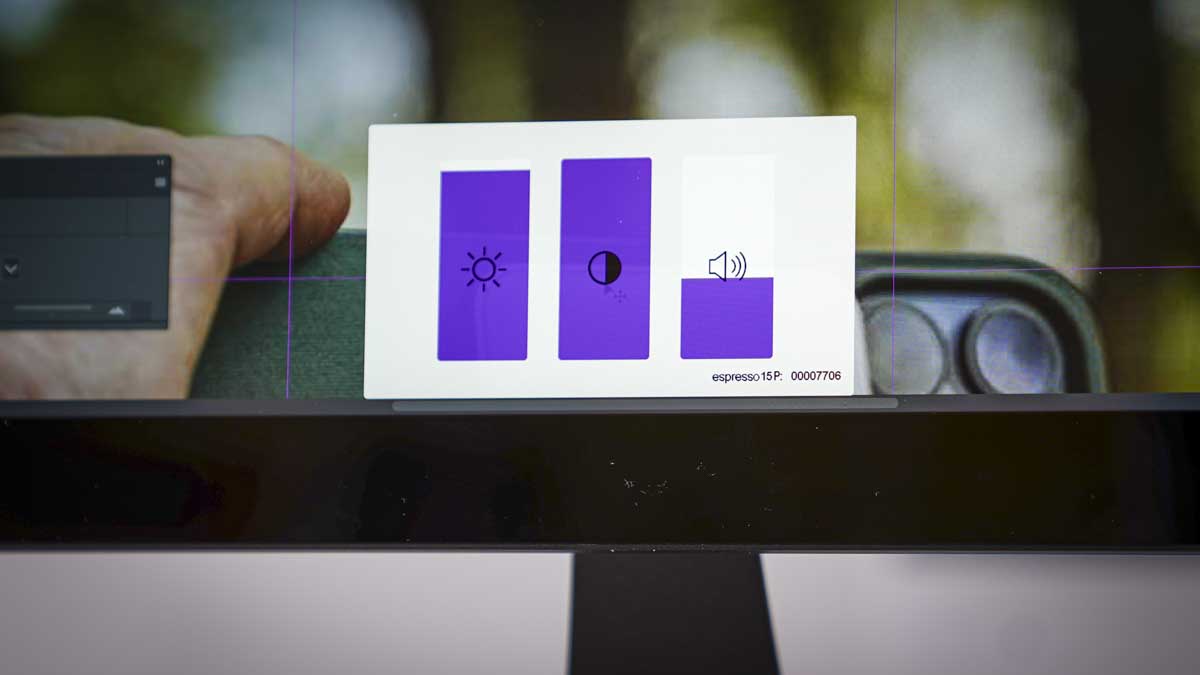
espresso 15 Pro: Features
When it comes to features, I think one of the major ones for me has to be its pure simplicity. There is very little when it comes to buttons or features, and with its slim tablet design, it slips very neatly into a backpack or laptop slot without catching. It sits perfectly beside your laptop, making it extremely portable.
Once all the software is installed and the system is set up, the espresso Pro 15 is extremely straightforward to use. Essentially, if you're using it with your laptop, it's just a single cable that connects directly to your laptop, and that's all you need. For other devices that don't have the power to run the monitor, an additional power supply is needed, but most power banks will be able to provide the necessary output to enable this monitor. There is also the optional charge power station available from Espresso.
The stand is exceptionally well-designed, with the stand plus enabling you to support the monitor in the usual way. If you stretch it out, it will position itself so that you can essentially place the espresso monitor above your MacBook Pro 15-inch display, making for a very neat and tidy workspace, even when on the move. Another great feature is the magnetic attachment, which allows the monitor to magnetically attach to the back of the stand, avoiding tricky clips and enabling you to securely attach and easily remove the monitor when transporting the unit.
In terms of headline features, I've already mentioned the dimensions and weight in the design section, but the brightness of the screen is another key point. It matches the MacBook Pro's 550 nits, and the display is an LCD IPS panel capable of 4K (3840 x 2160p). While this is above most laptop monitors, it does enable 4K output through the USB-C port, which is especially useful for those working in the creative industry.
Of more interest to both business and creative users is the fact that the screen covers 100% Adobe RGB and 91% DCI-P3, meaning the colour tone representation on the screen should be consistent between your MacBook Pro and studio machines and this monitor once properly calibrated. It also displays up to 1.07 billion colours, far more than most portable monitors.
Once the espresso Flow software is been installed, the monitor integrates closely with either Mac or PC systems. For instance, if you want to rotate the monitor from landscape to portrait, it will do this automatically without the need for fiddling around with any settings or options.
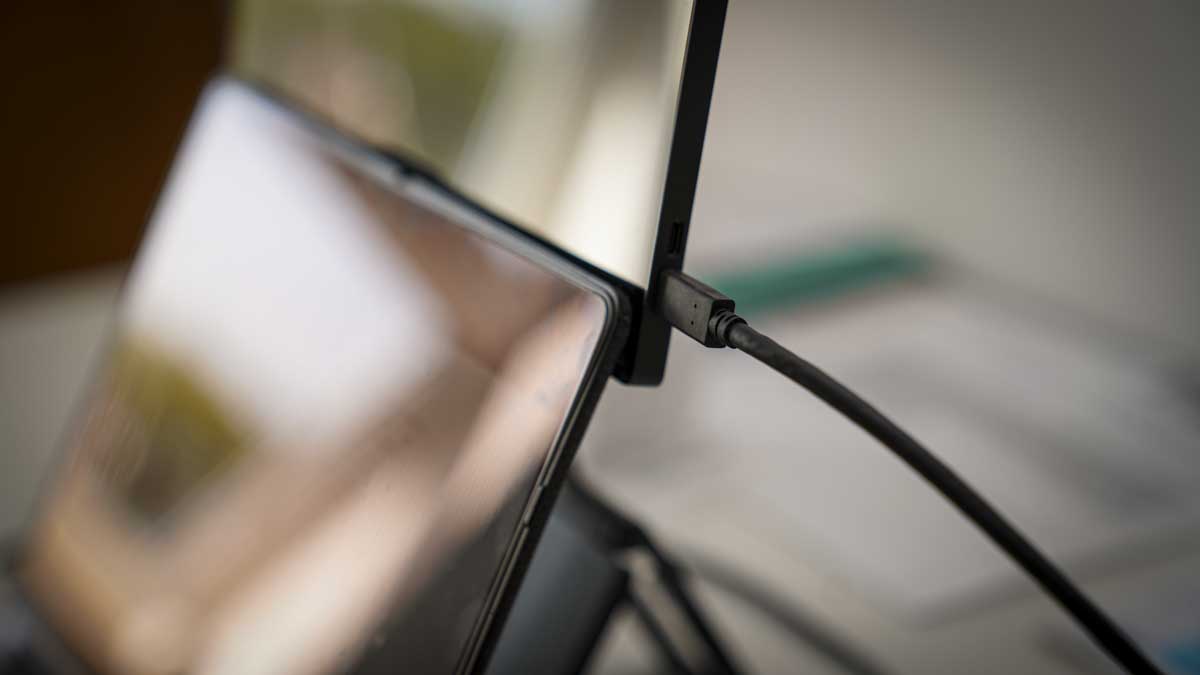
- Features: 4.5 / 5
espresso 15 Pro: Performance
This monitor is actually available in two sizes: the 15-inch model that I'm reviewing and the larger 17-inch version that Mark reviewed last year. I have to say that I prefer the 15-inch size, as it matches the MacBook Pro monitor, making it sit neatly beside or on top of the laptop, providing a much more intuitive workflow than switching between a larger or smaller monitor.
Getting started, the monitor was exceptionally quick and easy to set up. I simply plugged in the cable to the USB-C port, and the monitor was instantly recognised, popping up as a new MagicPad had been attached. Once I allowed that connection, the touchscreen functionality worked right away, something that Mark found wasn't the case with the 17-inch version last year.
However, I still installed the espressoFlow software, at which point a few additional options and settings became available through the interface, including auto-rotation—always handy when switching from landscape to portrait orientation.
Setting up was exceptionally easy, and I have to say the magnetic stand is a real standout feature. If you want the monitor right next to your laptop, the magnetic stand lets you adjust the angle and height to match your laptop's, creating a really intuitive workflow. If you want it raised above your laptop, the stand allows you to do this. This is something I haven't seen on other portable monitors before, and it's really well-designed.
For the most part, using the monitor with the laptop was excellent, with the screen resolution, tone, and colour being on par with the MacBook Pro's display, which is something that's not very common, even with other premium monitors. However, the one thing that was a little disappointing was the limited options available through the on-screen display (OSD). There are only three options: brightness, contrast, and volume. It would have been nice to have some presets that could be quickly accessed.
The refresh rate is also somewhat limited at 60Hz. For most uses, this is perfectly fine, but if you're into gaming, you might find that refresh rate a bit limiting. However, keep in mind this monitor is designed primarily as a high-quality business and creative tool, not for entertainment.
This becomes particularly evident when watching videos. While the visual quality of motion, tone, colour, and brightness for movies and TV shows is exceptional, the audio quality is quite light, with very little depth to the tone. In fact, when using it with a MacBook Pro, it's best to retain the use of the MacBook Pro speakers rather than switching to the monitor's speakers, as the quality is much lower.
Pushing the boundaries of this monitor, you can also take it away from the laptop and plug it into an iPhone, iPad, or any other device with the ability to output display via USB-C or HDMI. The monitor itself only features two USB Type-C ports, but if you have a USB-to-HDMI adapter, you can connect it to any HDMI output device. The caveat here is that you'll need to supply the monitor with its own power source, which is one of the reasons the charge power station is available, or you can simply plug in any generic power station. The monitor requires roughly 9 to 13W of power, though I found it fluctuated between 7 and 10W with the brightness set at around 75%.
One feature I really liked was the ability to plug an HDMI cable into a Sony Alpha 7 IV camera and then plug the USB Type-C connector into the monitor. This gave me a large screen to work with during workshops. While this may not be a common use case, it's extremely handy and highlights the versatility of this style of monitor.
Another big feature is that the monitor is fully touchscreen-enabled. From the basics of swiping up from the bottom of the monitor to bring up the screen display to adjust the brightness, contrast, and volume, it's also fully functional as a drawing pad or touchscreen-enabled device. It integrates seamlessly with both macOS and Windows, allowing for a full touchscreen interface.
Alongside the flow software, espresso also created an application called Jot, which I really like and shows how well thought out this monitor is. Essentially, it's a full jotting program, so if you have the pen (which I didn't have for this review), you can use it to jot down notes, draw, and much more. The speed and responsiveness of Jot are exceptional, and when used with the pen, the drawing tools, pen, text, and shapes work flawlessly. For a free app, it's really well integrated and allows you to interact with other applications. While I didn't fully test this feature without the official pen, I found that even using a generic pen, you could copy and paste creations from Jot into almost any other application. This makes it a great tool for quickly scribbling down notes or making a drawing and then pulling it into apps like PowerPoint or Word. It's a really nice addition to the workflow.
Overall, the monitor is exceptionally useful, and when coupled with the software—both Flow for management and Jot for drawing and note-taking—you have a really complete product that finally meets the needs I personally have from a portable monitor.
- Performance: 4.5 / 5
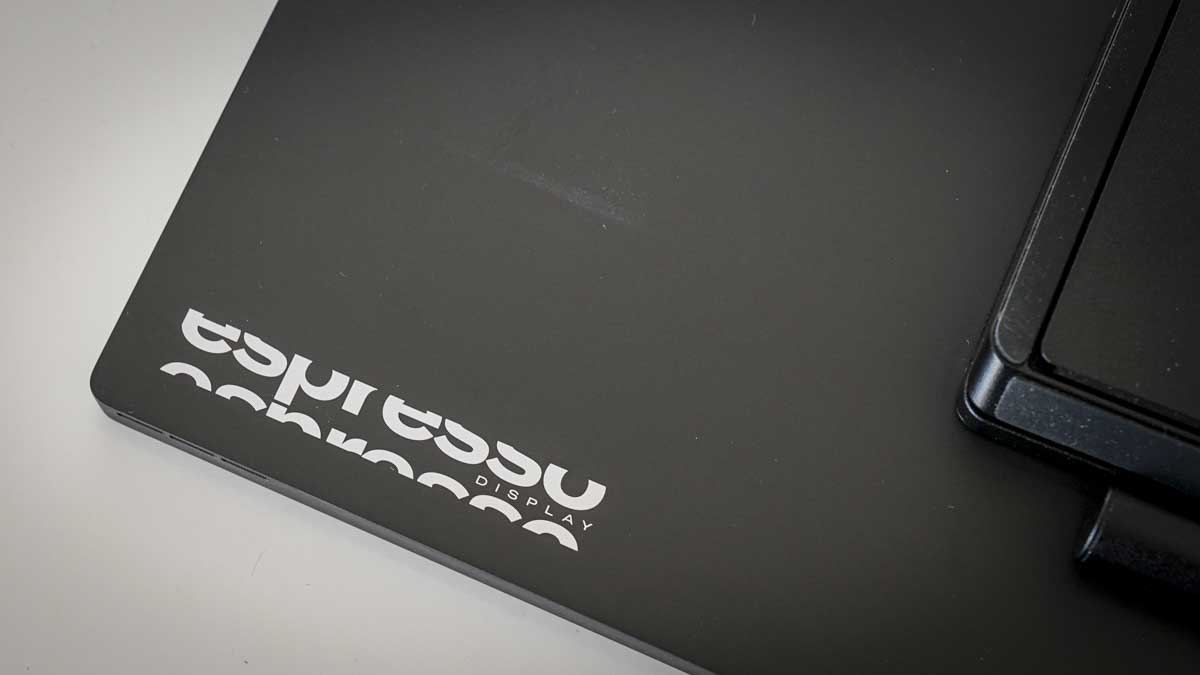
espresso 15 Pro: Final verdict
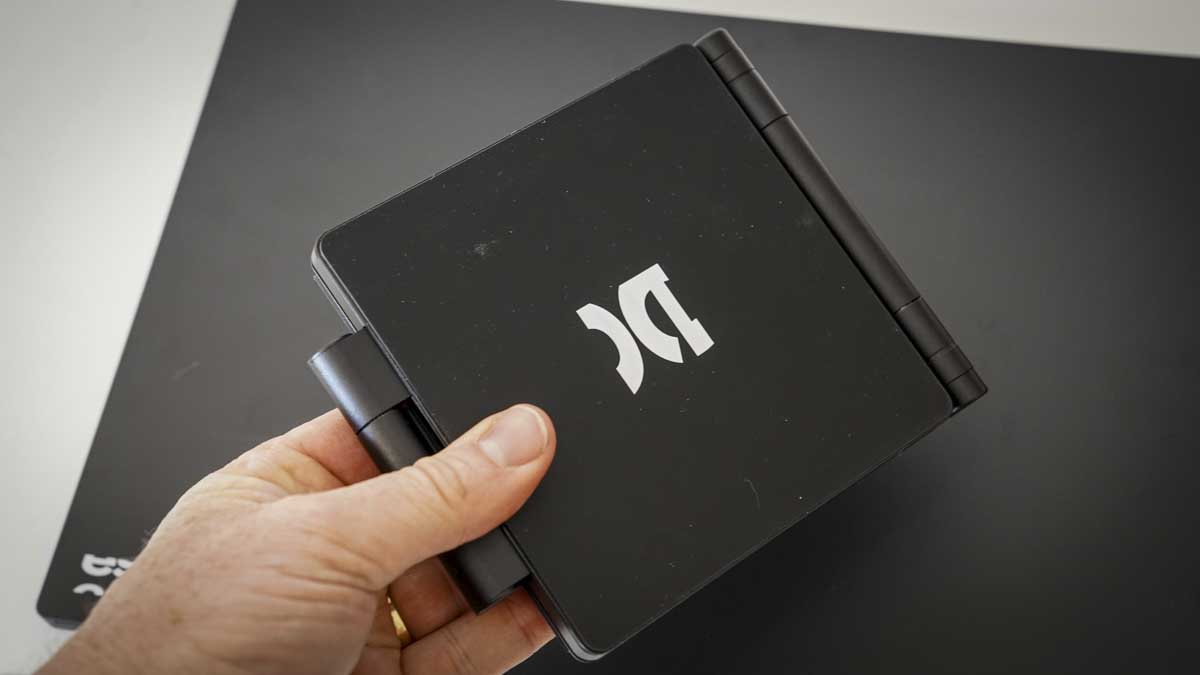
I'll quickly run through a few of the points I don't like about the monitor because, on the whole, this is a superb portable monitor option and the fact that its touchscreen takes it to the next level. So, what are the negative points?
The first is that there is limited control over the screen. There are no OSD (on-screen display) settings and no gamma control—just brightness, contrast, and volume. I would have liked to have seen more professional control over the quality of the display for a monitor at this price.
Next is the audio quality. The speakers are really not great at all. Compared with the depth of audio from most laptops these days, the speakers are really just a token offering. If you think of them as just a basic, built-in speaker, you'll be fine, but if you want anything more, I'd recommend looking elsewhere.
Another point is the weight. Due to the high-quality aluminium frame, which is really quite lightweight for the build, it is still heavier than other portable monitors of this size, weighing in at 800g. However, this is an issue I'm willing to overlook due to the build quality, especially when you consider the additional weight of the stand.
More of an issue for me was the fact that, while the screen is exceptionally high-quality, it is quite reflective. In most indoor locations, this wasn't a problem, but I did find it a little more reflective than the MacBook Pro screen, meaning you need to be more wary of glare, especially from light sources.
That said, this monitor is exceptionally good. The brightness, the close match to the MacBook Pro monitor's quality, and the touchscreen sensitivity make it an exceptionally good portable monitor.
For me, working with photography and video, the fact that this monitor covers such a high value of Adobe RGB and has such decent brightness makes it extremely versatile. It's one of the best portable monitors I've come across.
Throughout testing, using a host of applications—from daily tools like Photoshop and Premiere Pro to DaVinci Resolve, Final Cut Pro X, and even administrative apps like PowerPoint, Word, Excel, and Chrome—I was impressed with the overall quality of the display, not just visually but also through the build quality, which gave me reassurance when the monitor was in my bag. It felt safe and secure, and the stand held up well while being carried around.
This is truly a professional portable monitor. It's one of the best units I've reviewed, and I would highly recommend this version due to its superb build quality, size, and screen quality.
Should I buy a espresso 15 Pro?
Value | Expensive, but worth it for the features and display quality | 4 |
Design | Simple and stylish design with easy functionality | 4.5 |
Features | A few features for what is essentially a display, although I would have liked more options for display adjustment | 4.5 |
Performance | Display performance and functionality are superb—just ignore the speakers | 4.5 |
Overall | This is one of the best portable monitors on the market, perfect for creatives as well as business professionals | 4.5 |
Buy it if...
You need Adobe RGB
If you're looking for a portable monitor that features full Adobe RGB and 4K resolution at a decent brightness, the espresso Pro 15 ticks all the boxes.
You want absolute simplicity.
With just two USB ports, the profile of this portable monitor is extremely simple. There's very little to fault when it comes to the design.
Don't buy it if...
Don't buy it if...
You want a possible gaming monitor.
This monitor is tuned for business and creative use, so with a refresh rate of just 60Hz, it won't be an ideal option if you're into gaming.
You need a monitor with power
There's no built-in battery, and while most devices will be able to supply the monitor with power (at between 9 and 13W), it is something you'll need to consider.
For more essential hardware, my team and I tested and reviewed all the best business laptops around.
Alastair is a photographer, filmmaker and tech writer who has been working in the publishing industry since the late 1990s. For more than 25 years he has covered photography, video and technology across Future's photography, technology and gaming brands. He runs a photography and video production company and lectures in TV and film. He can usually be found testing mini PCs or prototyping and prop building with the aid of 3D printing.
You must confirm your public display name before commenting
Please logout and then login again, you will then be prompted to enter your display name.
